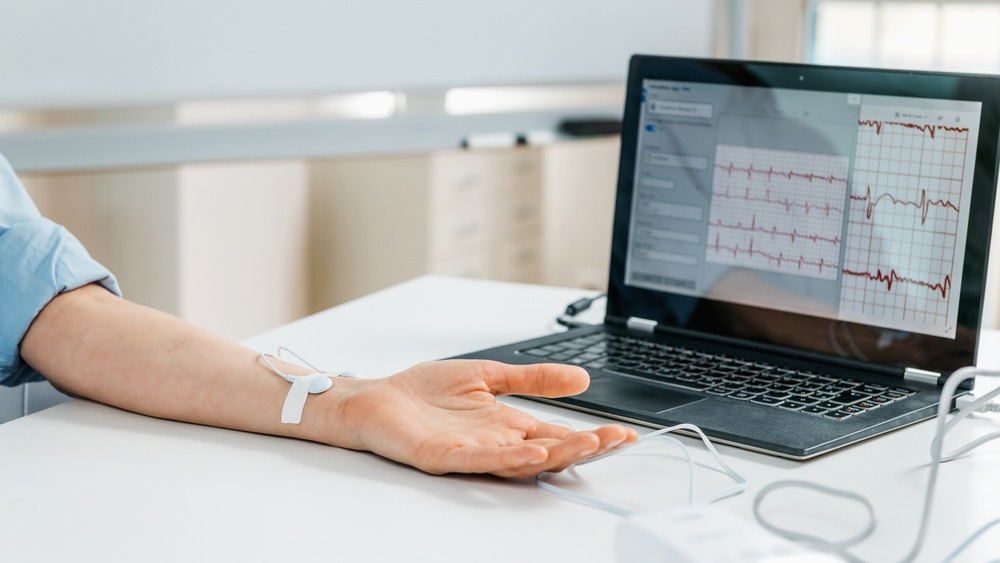A recent article published in BMJ discussed the prevalence, assessment, and practice pointers for the management of presentations of tachycardia among long coronavirus disease (long COVID).
 Study: Orthostatic tachycardia after covid-19. Image Credit: Microgen/Shutterstock
Study: Orthostatic tachycardia after covid-19. Image Credit: Microgen/Shutterstock
Background
Long COVID is the persistence of symptoms associated with coronavirus disease 2019 (COVID-19) for more than a month after recovering from acute severe acute respiratory syndrome coronavirus 2 (SARS-CoV-2) infections.
Long COVID symptoms are wide-ranging and vary across patients, with common symptoms such as fever, headaches, fatigue, loss of taste and smell, shortness of breath, and more serious complications involving the nervous, cardiovascular, gastrointestinal, and renal systems.
Patients with long COVID could present with palpitations or tachycardia, accompanied by dyspnea, dizziness, sweating, fatigue, chest pain, and bloating related to dysautonomia. The varied presentation of long COVID symptoms, the lack of clarity about the pathogenesis, and the absence of approved treatment methods have made long COVID-related tachycardia difficult to diagnose and manage. The authors presented an overview of long COVID-associated orthostatic tachycardia and key steps to diagnose and manage the condition.
Orthostatic tachycardia
The autonomic nervous system regulates physiological conditions such as respiration, digestion, blood pressure, and heart rate. Dysautonomia encompasses a wide range of dysregulations of the autonomic nervous system, including neurocardiogenic syncope in faint cases to postural orthostatic tachycardia in pervasive dysregulation conditions. Rare full-blown dysregulations also result in multiple system atrophy.
In long COVID patients, a sustained heart rate increase of 30 beats per minute to more than 120 beats per minute upon standing associated with symptomatic problems for a minimum of three months can be diagnosed as postural orthostatic tachycardia. These symptoms can vary with increasing cortisol levels in the morning, as well as in response to an increase in ambient temperature, alcohol consumption, exertion, and food.
Diagnosing orthostatic tachycardia requires excluding conditions such as orthostatic hypertension and other tachycardia precipitants such as fever, dehydration, sepsis, anemia, hypothyroidism, cardiac conditions, pulmonary embolism, and Addison’s disease. While some patients who attend long COVID clinics do not meet these criteria, the tachycardic symptoms presented are similar, and they respond to the management strategies recommended for orthostatic tachycardia.
Long COVID-associated dysautonomia is seen mostly in younger individuals and is more prevalent in the female sex. Although it is unclear whether comorbidities and the severity of COVID-19 are involved in the development of tachycardia, immunosuppression, obesity, and hypertension have been thought to play a role.
Chronic inflammation, hypercoagulability, immune-mediated mechanisms, baroreflex impairment, and direct injury to the autonomic nervous system by SARS-CoV-2 are possible mechanisms of the pathophysiology of orthostatic tachycardia.
Presentations and assessment
The authors described three case histories where patients presented with orthostatic tachycardia. In one case, the patient experienced palpitations upon standing, unambiguously diagnosed as orthostatic tachycardia. In the second case, while the patient did experience palpitations, cardiorespiratory symptoms were predominant. Tachycardia was diagnosed only after determining that the symptoms were precipitated by standing and not by exertion. The third patient experienced a dramatic increase in heart rate upon standing and an ‘electric shock’ sensation which is common in cases of orthostatic tachycardia.
Clinical assessments must include determining acute cardiac symptoms, ascertaining the occurrence of tachycardia upon standing, and whether it is accompanied by nausea, dizziness, and tightness in the chest. The authors recommend that investigations be tailored to the medical history, with various blood tests, chest X-ray imaging, heart rate monitoring, and electrocardiography (ECG) to make a proper diagnosis.
Management measures
Non-pharmaceutical options include a liberal intake of fluids and salt in cases where it is considered safe. Wearing compression hosiery that reaches the waist and avoiding triggers such as warm places, prolonged standing, alcohol, and heavy meals are also recommended. While isometric exercises are advised for physical reconditioning, patients are also encouraged to pace themselves.
The pharmaceutical options include α and β-blockers, ivabradine (an If channel blocker), anticholinesterase inhibitors, peripheral vasoconstrictors, and volume expanders. The article presented details on how these drugs work and the conditions in which they can be prescribed.
Self-care mechanisms include minimizing activities that cause physical, emotional, or mental stress. Avoiding blue light, caffeine, and alcohol to optimize sleep schedules, pacing activities, diet changes to adopt a more healthy, Mediterranean-style diet to reduce bloating, and relaxation techniques such as yoga and meditation have also been recommended as methods through which patients can improve their wellbeing.
The practice pointers also list the conditions in which a patient should be referred to a specialist and the general prognosis for patients depending on the treatment recommendations and comorbidities.
Conclusions
To summarize, this practice pointer discussed the presentations of tachycardia in long COVID patients and the criteria for the clinical assessment. The authors also presented various non-pharmaceutical and pharmaceutical options to treat and manage orthostatic tachycardia in long COVID patients.